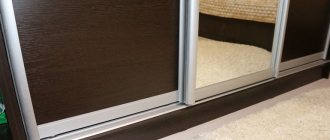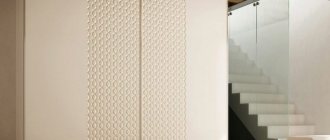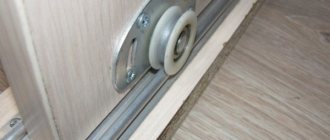Hinged compartment doors , if you think about this phrase, it actually sounds somehow absurd, but this name has become firmly established in the everyday life of furniture manufacturers.
A compartment door is a panel with upper rollers and lower support wheels, which slides along guides. The swing door does not slide anywhere, but opens, swinging open due to the hinges. Thus, as a result, we have a door that is made of the same profile as compartment doors, but it swings open using special mechanisms.
You can visually see how a sliding compartment door differs from a swing door in the photo below:
Pivot mechanism for sliding wardrobe doors
You know exactly what a compartment door looks like. So, the hinged compartment door looks exactly the same. It just opens like regular swing doors. The need for such a system arose because the openings were too narrow, where it was impossible to install two sliding doors.
The pivot door opens using a mechanism fixed to the door handle profile. Which in turn is recorded in the pivot track. The track is attracted to the lower and upper horizontal strip of the opening. If the floor and ceiling are level, then you can do without planks.
The mechanism itself is simple - an aluminum sleeve is inserted into a hole made of hard plastic. For this reason, there are restrictions on the width and weight of the door. You should not assemble high glass or mirror doors wider than 500 mm. Once I managed to catch one :), during installation.
Components of a hinged coupe door
- Track (upper and lower) 2 pcs.
- Mechanism (top and bottom) 2 pcs.
- Magnetic stopper 2 pcs.
Hinged coupe doors calculation
Very often I made mistakes when calculating the height. When the door turned out to be large, I reduced the leveling strips leveling the floor and ceiling to the level, when it was small, the system made it possible to adjust the mechanism up to 25 mm, although the gap appeared terrible. Only upon closer examination did I notice what my mistake was.
Height
To calculate the height of a hinged compartment door, you must first purchase a pivot track. The fact is that there are two types of them and it is difficult to predict which one you will get. The difference between them is 5 mm, which is significant for this mechanism.
Look at the photo and notice the difference. With the track on the left side, subtract 21 mm from the height of the opening. With a track on the right side - 25 mm. It's all about the curved base of the track on the left side, on the right the base is flat. The height bend is 2 mm. The track below and above is a difference of 4 mm.
In order not to remember the numbers, you should understand where they come from. Screw the mechanism to the profile and put on the track. The distance from the end of the profile to the outer edge of the track will be the size separating the height of the door from the opening. Because mechanism on top and bottom × 2.
When the opening is known, we subtract the resulting size from it and get the size of the door. Let's say the opening height is 2500 mm. The mechanism with track is 10.5 mm. Multiply by 2 Top Bottom equals 21 mm. 2500 – 21= 2479 mm door height size.
Width
To be honest, the width is more difficult. It all depends on the correctness of the opening, i.e. How smooth are the side walls? Accordingly, we calculate the width of the door from the smallest width of the niche. I subtract 10 mm, 5 mm on each side. It is impossible to make smaller gaps.
This is because the profile of the handle, when opening, begins to touch the side wall if the gap is made smaller. The axis of rotation is located far from the edge of the door and the profile has a shape that protrudes strongly forward. That same handle is what blocks the door. I’m not sure I explained it clearly. If it’s not clear, write in the comments. I'll make a video.
In the photo there is a square instead of a wall
There is one more nuance. Hinged compartment doors are placed on corner openings, and this happens even more often than on straight ones. This is their advantage and disadvantage. The advantage is the ability to close the corner niche. The disadvantage is the difficulty of preliminary calculation of the door width.
If we are making a cabinet cabinet, then there is a fixed size of the corner opening. When assembling a swing door without filling, using the poke method, I adjust the door width. Those. Initially, I saw with a margin of width and adjusted only the door frame.
When installing a built-in wardrobe, it is difficult to immediately calculate the width and degree of the corner niche. And so I make a template according to the width of the resulting opening. Using the template, I will later make a hinged compartment door. There is no exact formula for calculating the width at the corner.
I wrote about how to calculate the filling of a compartment door in this article
Assembling a hinged compartment door
A pivot door is almost no different from a sliding door and therefore assembly follows the same pattern. There are no rollers on the swing and, accordingly, we do not drill the handle profile for them. The pivot mechanism is attached through the same holes as the horizontal profile.
We mark the necessary holes and drill first with a 7 or 8 mm drill, and then drill the outer wall of the profile with a 10 mm drill. For free penetration of the bolt head. To assemble a hinged compartment door you will need a flat table, hexagons and a mallet.
Installation of sliding compartment doors
I'll tell you how I do it. First of all, I screw the tracks to the very edge, from the side where the mechanism is mounted. I insert a plastic fastener into the bottom one, tightening it slightly so that it does not dangle. I take the door and insert the lower bushing into the plastic mount.
In the photo, the plastic mount is turned upside down relative to the bushing
Pivot mechanism
You know exactly what a compartment door looks like. So, the hinged compartment door looks exactly the same, only it opens like regular hinged doors. The need for such a system arose because the openings were too narrow, where it was impossible to install two sliding doors.
The pivot door opens using a mechanism fixed to the door handle profile. Which in turn is recorded in the pivot track. The track is attracted to the lower and upper horizontal strip of the opening. If the floor and ceiling are level, then you can do without planks.
The mechanism itself is simple - an aluminum sleeve is inserted into a hole made of hard plastic. For this reason, there are restrictions on the width and weight of the door. You should not assemble high glass or mirror doors wider than 500 mm. Once I managed to catch one :), during installation.
Components of a hinged coupe door
Hinged coupe doors calculation
Very often I made mistakes when calculating the height. When the door turned out to be large, I reduced the leveling bars; when it was small, the system made it possible to adjust the mechanism, although a terrible gap appeared. Only upon closer examination did I notice what my mistake was.
Height
To calculate the height of a hinged compartment door, you must first purchase a pivot track. The fact is that there are two types of them and it is difficult to predict which one you will get. The difference between them is 5 mm, which is significant for this mechanism.
Look at the photo and notice the difference. With the track on the left side, subtract 21 mm from the height of the opening. With a track on the right side - 25 mm. It's all about the curved base of the track on the left side, on the right the base is flat. The height bend is 2 mm. The track below and above is a difference of 4 mm.
In order not to remember the numbers, you should understand where they come from. Screw the mechanism to the profile and put on the track. The distance from the end of the profile to the outer edge of the track will be the size separating the height of the door from the opening. Because mechanism on top and bottom × 2.
When the opening is known, we subtract the resulting size from it and get the size of the door. Let's say the opening height is 2500 mm. The mechanism with track is 10.5 mm. Multiply by 2 equals 21 mm. 2500 – 21= 2479 mm door height size.
Width
To be honest, the width is more difficult. It all depends on the correctness of the opening, i.e. How smooth are the side walls? Accordingly, we calculate the width of the door from the smallest width of the niche. I subtract 7mm, 3.5mm on each side. It is impossible to make smaller gaps.
This is because the profile of the handle, when opening, begins to touch the side wall if the gap is made smaller. The axis of rotation is located far from the edge of the door and the profile has a shape that protrudes strongly forward. That same handle is what blocks the door.
There is one more nuance. Hinged compartment doors are placed on corner openings, and this happens even more often than on straight ones. This is their advantage and disadvantage. The advantage is the ability to close the corner niche. The disadvantage is the difficulty of preliminary calculation of the door width.
If we are making a cabinet cabinet, then there is a fixed size of the corner opening. When assembling a swing door without filling, using the poke method, I adjust the door width. Those. Initially, I saw with a margin of width and adjusted only the door frame.
When installing a built-in wardrobe, it is difficult to immediately calculate the width and degree of the corner niche. And so I make a template according to the width of the resulting opening. Using the template, I will later make a hinged compartment door. There is no exact formula for calculating the width at the corner.
I wrote about how to calculate the filling of a compartment door in this article
Assembling a hinged compartment door
A pivot door is almost no different from a sliding door and therefore assembly follows the same pattern. There are no rollers on the swing and, accordingly, we do not drill the handle profile for them. The pivot mechanism is attached through the same holes as the horizontal profile.
We mark the necessary holes and drill first with a 7 or 8 mm drill, and then drill the outer wall of the profile with a 10 mm drill. For free penetration of the bolt head. To assemble a hinged compartment door you will need a flat table, hexagons and a mallet.
Installation of sliding compartment doors
I'll tell you how I do it. First of all, I screw the tracks to the very edge, from the side where the mechanism is mounted. I insert a plastic fastener into the bottom one, tightening it slightly so that it does not dangle. I take the door and insert the lower bushing into the plastic mount.
Then I carefully insert the upper fastener into the track and tighten the fastener, but not thoroughly. If necessary, I adjust the mechanism in height. I set the side gaps by moving the door left or right. The tracks must be in one line, otherwise the door will open.
Having tightened the fixing black bushings, I proceeded to attach the stoppers. They consist of two parts - a magnet and an iron disk with a countersunk hole for a self-tapping screw. Place one at the top and bottom. We attach the magnet to the cabinet and screw the iron disk to the profile, having previously drilled it.
The door must fit both stoppers and be secured by them. If the door still turns out to be heavy, to be sure, I drive the thirtieth yellow screw into the plastic part. There are free holes there. Thus, attracting it along with the track to the ceiling.
Conclusion
I understand that I have not fully opened your eyes on this topic. But I know for sure that now you will be more confident in using the pivot system in your products. And don’t forget that I am always within walking distance of you. Ready to help you at any time.
Source
Choosing loops
To choose the right number and types of loops, you need to take into account the dimensions of the fabric, as well as the location of these same loops. If the structure is double-leaf, then both doors are mounted on hinges on both sides. To hang a door with one leaf, correct calculations are required.
- Depending on the location of the door, you need to choose either right-handed or left-handed hinges.
- The size of the loops depends on the weight of the structure itself. For a double-leaf door, two hinges per leaf are sufficient, but a single-leaf door, as it is heavier, requires more hinges. Most often, a single-leaf door is secured with three hinges.
- Be sure to check the hinges when they are open, as many products have a bent hinge.
- The color scheme of the fittings should match the color of the door itself.
Which mechanism for sliding doors is better?
Both the support and suspension systems have both advantages and some inherent disadvantages. In most cases, slab panels are equipped with hanging mechanisms, and frame facades are equipped with supporting ones; Interior sliding partitions and children's furniture are equipped with suspended versions of sliding door systems, and standard-height sliding wardrobe doors are bottom-supported. In general, the lower support mechanism is considered more reliable and safe, since doors equipped with it rarely fall out of the opening.
Top-hung system "Puerta"
Bottom support sliding door system "Ramir"
The choice in favor of a specific sliding system for a wardrobe is made depending on the design load, the filling option and dimensions of the facades, the installation location of the furniture, the characteristics of its operation and other factors. If necessary, our employees will help you make your choice, provide free advice, and answer thematic questions about the production of compartment doors to individual sizes.
Correct installation
How to hang a door on hinges so that the entire structure is reliable and safe to use? To do this, you need to prepare tools in the form of a plumb line, a level, a drill with a speed controller, a screwdriver, a chisel, a hammer and a tape measure. Installation of hinges is carried out as follows:
- The distance from the top and bottom edges of the door leaf should be at least 20 cm.
- If there is a third loop, it should be placed in the middle between the first and second.
- If there are four hinges, then the height of the door is divided into 5 segments, onto which the fittings are attached.
- The upper parts of the hinges are attached to the door leaf, and the lower parts (with rods) are attached to the frame.
- We apply the loop to the end of the fabric at a predetermined distance.
- We fasten the fittings to the door with self-tapping screws, using a drill or screwdriver. It is important that the diameter of the drill is thinner than the diameter of the screw, which will ensure reliable fixation of the hinges.
- Now we install the door in the frame, open it slightly and add one of the canopies to the bottom of the hinge so that it fits tightly to the frame. We outline this place with a pencil, and repeat the same steps with the remaining loops. The door can now be removed.
To hang the doors with your own hands as carefully as possible, you need to remove the top layer of wood in the areas outlined. The lower hinge canopies will be attached to the resulting recess. It is important that they are positioned horizontally, then the door will open easily and smoothly.
Lifting mechanisms. EI-9011 series frequency converter in variable frequency drive
Load lifting mechanisms using an electric drive are installed on all lifting machines. Their general design is typical not only for cranes and elevators, but also for special-purpose machines, in which the direction of the force application vector from the load may coincide with the direction of rotation of the electric motor rotor.
The simplest version of the mechanism is a cargo winch. This is a machine for lifting loads using a rope wound on a drum with a hook in the form of a hook.
Basic kinematic diagram of the lifting mechanism
Electric drive of the lifting mechanism
The most common electric motor for the lifting mechanism is an asynchronous electric motor with a squirrel-cage rotor. Despite the simplicity of control (direct start), it has significant disadvantages:
- high starting currents,
- large dynamic loads at startup.
To some extent, they can be eliminated by using an electric motor with a wound rotor. But a new disadvantage appears - bulky power switching equipment.
The highest performance indicators can be achieved by using a variable frequency drive, namely:
- reduce starting currents to the rated level,
- reduce dynamic loads to the design level,
- smoothly adjust rotation speeds over a wide range.
Application of EI-9011 series inverter to control the lifting mechanism
When choosing a Vesper frequency converter, first of all you need to take into account the type of gearbox of the lifting mechanism. There are 2 main types:
- cylindrical,
- worm.
The difference between these gearboxes is that the cylindrical gearbox is double-sided, i.e., torque is transmitted both from the input shaft to the output shaft, and vice versa - from the output shaft to the input; and the worm is one-sided. The latter is installed less frequently - due to low efficiency and increased wear.
In lifting mechanisms with worm gear
It is possible to use any Vesper frequency converter of the EI, E3, E4, E5 series. But we will not consider the use of VFD in such a mechanism - due to the lack of features of its operation.
For lifting mechanisms with helical gearboxes
It is recommended to use frequency converters of the EI-9011 series, due to the presence of:
- A powerful central processor that allows you to create software for vector mode with high precision characteristics and wide functionality.
- Two vector modes: open-loop and with speed feedback sensor.
- Wide speed control range: 1/100 in normal vector mode and 1/1000 in closed-loop vector mode.
- Vector mode with feedback, which provides M=100% at almost zero engine speed.
Checking the door
After the hinges are installed and the door is hung, you need to check its functionality. If you suddenly hear a creaking noise when opening or closing, lubricate the hinges with some compound - machine oil, grease, technical petroleum jelly. If the hinges are cut too deeply, do not despair: this situation can be corrected by using a rubber gasket, thick cardboard or hardboard.
If the canvas ends up being too low and therefore scratches the floor, you need to raise it. To do this, a washer is placed between the hinge canopies, after which the entire structure is raised. As you can see, hanging a door is not as difficult as it seems, especially if you approach this process responsibly and pay timely attention to each defect.
Strategies based on Pivot levels
The essence of using Pivot Point is the same as in the case of regular support and resistance lines. They can be used both for range trading (between levels) and for trading on a level breakdown.
In the case of range trading, a bet is made that the level will not be broken and the price will rebound from it. In trading for a level breakdown, on the contrary, a strong price movement is expected after the level in question is broken.
When using any of these strategies, it will never be superfluous to verify the significance of the traded level by finding it on the chart of two (or even more) time frames at the same time.
Or you can combine these two strategies into one, and trade simultaneously on the breakout of the level and in the range. The bet here is that the price will most likely be reflected from the next level, but if it suddenly breaks through it, then the consequence of this breakout will be a fairly strong price movement.
That is, we need to be prepared for any of these two scenarios. You can sit at the monitor and wait for the price to either bounce off the level or break through it. Or you can use such a simple and effective trader tool as pending orders. Sitting and “waiting by the sea for weather” is an extremely boring and ineffective activity (in terms of the huge time spent on it). Therefore, in my trading, I, of course, use exclusively the second option, which I advise you to do as well.
A few words about pending orders
Pending orders are divided into two main categories:
We hang doors on the closet
Many people think that installing a door and hanging hinges is not the easiest process. But in fact, all the work can be done independently. To complete the work, you need to prepare polyurethane foam, anchor bolts and screws, a level, a chisel, a wood saw and a miter box. How to hang doors on a closet? To do this, you should follow several rules.
- Pay attention to proper marking: first mark the center, which is located at a distance of 22 mm from the edge and 12 cm from the end.
- Most often, two loops are attached - one at the top, the second at the bottom. This is the easiest and most convenient installation method, as the installation itself will be faster. However, if the structures are too large, more than two loops may be required.
- In the measured areas, holes are drilled with a drill into which the hinge cups are inserted. Most parts fit exactly into the hole sizes, allowing for complete installation.
- When working, you need to use tools with good sharpening, which will make the holes neat and of high quality.
- Before hanging the door, you need to check the operation of the hinges by positioning them correctly.
Features of working with a coupe
Each type of cabinet from a design point of view has its own characteristics, which is reflected in the need for correct hanging of hinges. Most often, furniture has hinged doors, but wardrobes are no less popular. When equipping it, the following types of loops are most often used:
- inset, having a facade and clearly visible ends of the sidewall of the frame;
- overhead: in this case, the facade is located on the hinge side and is superimposed on the ends of the side parts;
- angular: attached at an angle of 90-135 degrees relative to the holding unit;
- partially overhead: can be mounted in the form of two facades on one partition.
What depth should be built into the closet for such a door? For sliding doors it is usually 8 cm. Will it be possible to save on the required depth if you use hinged doors instead of sliding ones? Thank you
For pivot doors, the filling is minus 50 mm if the cabinet is straight.
Dmitry, what if it’s corner? And how is the guide attached, how far from the edge?
Hello! Depends on what degree of angle. Mainly in fact, so that the profile does not shuffle when opening.
I had problems adjusting the sash height. The screw does not tightly tighten the strip and sash. I can't figure out what the problem is. Could you give me some advice?
Source
- ← beer pipe in apartment fake
- pigment for facade plaster →
We act according to the rules!
How to properly hang a door on a wardrobe? It is worth starting by measuring the width and height of each opening and frame, checking the level of the roof, sides and panel that will serve as the floor. You should also measure the thickness of the cabinet walls, since over time, distortions may form in them. Compensation for distortions is possible thanks to overhead hinges that are easy to adjust. It is important to ensure that during installation all structural elements are located at the same depth. Installation of loops is carried out in the following order.
- The hinges are applied to the place where they will be attached, holes are marked and drilled to a depth of 20-30 mm.
- The holes are made both at the ends of the sidewall and on the door itself.
- The hinge halves are fixed using furniture screws.
- The door is hung.
Where to buy and how to order?
You can buy mechanisms for sliding wardrobe doors in Moscow at an affordable price from the RIAL-MOSCOW company. To begin with, we recommend that our clients familiarize themselves with the assortment presented in the catalog of this site. This will give a complete picture of what is relevant today and what can be ordered.
The cost of a sliding wardrobe door system is directly determined by the type, strength and durability of the materials from which each of its elements is made, including the covering option. We work with wholesale and retail clients. For the former, a system of discounts is provided, depending on the volume of purchases.
Applications are accepted on the website or by phone.
Difficulties of work
Many people are interested in the question of how to hang a compartment door if there are internal drawers next to them. In this case, shelves and drawers located on the inside should be somewhat shorter in depth than the external elements. During installation, you should also pay attention to the fact that dead zones may form at the intersection of the frames. If drawers get caught in them, then it will be impossible to open them and they will lose their functionality. In general, experts do not advise installing sliding doors yourself, since each sliding system has its own characteristics, the door is rigidly tied to the frame, and therefore you can simply ruin the furniture.
Sliding compartment door
| Rice. 1. Sliding compartment door |
- vertical profile compartment door handle
- top guide
- cross divider
- lower connection profile
- bottom guide
- top rollers
- cross divider with seal
- dividing frame
- bottom wheel
- side plug for double row guide
- stopper
We follow the stages
Whatever door you hang - in a doorway or a closet, you need to do it in accordance with a number of steps. Only in this way will the hinges be cut neatly and accurately, and the door will serve stably and properly. So, if you are installing a new structure, you will first have to start assembling the box. To do this, the side and top posts are cut out and connected with self-tapping screws.
When assembling the frame, you need to leave a gap of at least 5 mm - thanks to it, the doors will not be subject to friction and cycling after installation. Once the box is ready, you can install the hinges. But there are some nuances here too. For example, it is important to understand how much weight a door has - the number of hinges that will be required during its installation depends on this. The box can be attached in two ways. The first involves the use of foam if the door is lightweight, and the second - anchors, which is advisable for large structures. All holes can be carefully closed with decorative plugs.
You can handle most of the work yourself, but since hanging a wardrobe door is not so easy, it is better to entrust this work to professional craftsmen.
Source: autogear.ru
How to install swing doors in a wardrobe
Hinged compartment doors , if you think about this phrase, it actually sounds somehow absurd, but this name has become firmly established in the everyday life of furniture manufacturers.
A compartment door is a panel with upper rollers and lower support wheels, which slides along guides. The swing door does not slide anywhere, but opens, swinging open due to the hinges. Thus, as a result, we have a door that is made of the same profile as compartment doors, but it swings open using special mechanisms.
You can visually see how a sliding compartment door differs from a swing door in the photo below:
Door sizes?
In hinged cabinets, doors are installed up to 60 cm; in rare cases up to 70 cm; at low heights, up to 2 meters. This is due to the fact that the door will sag under its own weight and can tear out the fastening hinges.
In compartment doors, on the contrary, we make doors from 60 to 120 cm; The heavier the sliding door, the better and softer it moves along the guides.
Where and which cabinet to put for better use?
For a long narrow corridor, of course, a wardrobe is better suited. A hinged wardrobe is suitable for a small hallway or balcony.
Sliding systems
often used by interior designers. They have three main variations: interior sliding partitions, interior doors and doors for sliding wardrobes. This is a great solution for both home and office, which can not only hide the contents of the closet, but also effectively divide the space.
Sliding system Aristo
- there are many options for sliding and swing doors with an almost endless number of combinations. The profile system itself is made of aluminum alloy, which means they are lightweight, durable, do not rust and have a long service life. The door frame can look anything: from plain anodized to a wide wood-look palette, so you can take exactly the shade that will highlight the individuality of your interior or become a soloist in it.
The main constants of the uniqueness of Aristo doors:
Max.width up to 1500 mm,
Max.height up to 3200 mm.
Max. door weight up to 160 kg.
Max. load up to 80 kg.
Max. The service life of the sliding mechanism is 110,000 opening and closing cycles.
The lower roller is equipped with a metal bearing, as a result of which the door moves smoothly and quietly. The upper roller is made of durable polymer material. The rollers themselves are installed discreetly, which means dust will not get inside the device itself. And in general, the design of the Aristo roller mechanism is today recognized as reliable and durable among other sliding systems. The side profile is ergonomically shaped for opening/closing the door.
The inherent rigidity of the Aristo
, allows you to make composite doors in a variety of combinations both vertically and horizontally. For this feature, the Aristo sliding system is loved by interior designers and is widely used by them in their creative solutions.
For greater comfort, you can install a door closer in the doors of Aristo sliding wardrobes for shock absorption when sliding the door and a shlegel to prevent the diffusion of dust inside the cabinet.
The assortment also includes single-track guides and a rotating element, with the help of which swing doors are made. Taking into account the peculiarity of the hidden installation of rollers and the minimal elevation of the lower guide rail above the floor level, such doors can be installed as interior doors or as sliding partitions.
Design features and operating mechanism
The loop consists of the following elements: cup (1), shoulder (2), striker (3). The cup is inserted into a blind hole in the door, which is drilled with a milling cutter and fixed with two self-tapping screws through holes located on the flange (5).
A counterplate is fixed to the furniture wall with self-tapping screws, which is attached to the arm (2) and the cup using a mounting screw (6) and a mounting groove (7). An adjustment screw (8) is located on the arm to adjust the height of the arm relative to the strike plate and align the door after installation.
Design features of furniture hinges
To work you will need:
- drill: thin drills, milling attachment with a diameter of 35 mm;
- pencil, tape measure (ruler);
- screwdriver or Phillips screwdriver;
- building level.
Installation
First, mark the location of the loops in height. The number of furniture hinges depends on the dimensions and weight of the door leaf.
The distance from the top and bottom edges of the fabric to the loop must be at least 70 mm. Otherwise, the lower and upper horizons of the box may touch the loop.
It is convenient to make markings using a special device - a conductor
Then mark the location of the hole for the cup on the facade. To do this, at the required height from the edge of the blade to the center of the drilling, measure 21-23 mm.
The blade is placed on a hard and stable surface, and they begin to drill a “blind” hole with a milling cutter. All holes are located perpendicular to the plane of the facade and have a depth of 11-12 mm. After work, small shavings are collected with a vacuum cleaner.
And another option is to shorten the tenon using a grinder or sandpaper. Otherwise, you can drill through the canvas.
The cup is inserted into the holes, aligning the loop perpendicular to the edge. The holes for the screws are marked with a pencil, the hinges are removed, and the markings are deepened with a thin drill. The cups are placed into the holes and secured with self-tapping screws.
If you have no experience working with a cutter, you need to practice on scraps
Now you need to attach the facade to the cabinet frame, align it vertically and mark the places where the striker is attached. They are deepened with a drill, and the counter plate can be screwed on with self-tapping screws.
To ensure that the hinges are installed as level as possible, they can be supported with a wooden or metal strip.
Next, the façade is installed. A shoulder groove is inserted under the mounting screw of the bar. At the same time, make sure that the adjusting screw matches the groove on the strike plate.
Selection of body material
Here, of course, everything depends on your skills in working with this or that material. Sheet plastic, plexiglass, and plywood are used. The most accessible and easy-to-process material is probably plywood. It is distinguished from polymers by its unique pattern, which can be emphasized with the help of stains and varnishes. This is what we chose to make the pourer.
Which plywood is best suited for our purposes? First, when buying plywood, pay attention to its grade. The lowest grade is grade 4, which allows for any manufacturing defects. Whereas 1st grade plywood has virtually no flaws. A sheet of plywood can have sides of different grades, for example, the marking 2/4 means that one of the sides is of the second grade, the other is of the fourth. We don’t care about the grade for the inside of the pourer, but for the outside, a higher grade is preferable.
You should also decide in advance on the thickness of the plywood. What does it affect? In our case, the thickness of the plywood is 8mm, this allows us to glue it end-to-end without using tenon joints. But this thickness of plywood becomes a disadvantage when you need to install a button or encoder in it: the length of their thread is significantly less than 8mm. However, this can be solved by drilling a small recess in the plywood for the component to be installed (see the collage below). When using 3mm thick plywood you will not encounter such a problem. But it will no longer be possible to glue it at the end. But, again, this is not a problem: the pieces of plywood can be glued together using a wooden strip, as shown in the next collage on the right.
Adjustment and Leveling
At this stage, you need to work at the construction level - determine the correspondence of the frame parts to the door leaf. To do this, the level is applied to 3 planes - to the two sides and to the front. They should be as even as possible. That is, there should be no gaps or deviations between the frame and the door leaf.
Alignment begins with adjusting the vertical gap. To do this, pressing the facade against the frame, tighten the fixing screws on the strip. Then close the door and check the possible angles of inclination with a building level.
By adjusting the screws, all gaps between the facade and the frame are eliminated. For example, if the upper corner is tilted to the right, tighten the screws on the upper hinge and loosen the screws on the lower one.
Then they begin to adjust the doors according to their height. Two self-tapping screws located on the “ears” of the strike plate are responsible for this. To begin with, loosen the screws on all hinges, raise or lower the canvas (depending on the situation). Then tighten the screws until they stop, holding the facade in the desired position.
Installing hinges on glass doors
Four-hinged hinges for glass doors are distinguished by the presence of a special tab for attaching the cup and a cover for masking the device from the outside.
If you have no experience working with glass, it is better to turn to specialists to drill holes. Before this, you need to establish preliminary markings of the locations of the loop cups. At the same time, they also take into account the hole where the handle will be hung.
Overhead hinges are also used for glass doors, which can be hung without drilling glass.
You need to place and secure the cup in the drilled holes using a tab, and attach the counter plate to the box with self-tapping screws. Afterwards the door is aligned along three planes.
For glass doors, overhead hinges are also used, which can be hung and fastened without drilling the glass. They are mounted inside the box; accordingly, all shelves in the closet must be recessed inward. Suitable for light sashes only. For example, for the bookcase department.
Four-hinged hinges come in different modifications, which can be selected depending on the location of the panel relative to the box and the cabinet itself in the room.
Invoice
The canvas attached to this loop is completely perpendicular to the body and covers the stand. Used when the door overlaps the side rail of the cabinet.
Invoice
Half waybill
It is used when two doors need to be hung on one rack. Each facade overlaps the end of the rack by half.
Insert
The door leaf is perpendicular to the post, but does not overlap its end.
The overhead hinges also differ in the angle of inclination. This is necessary for installing corner cabinet doors. Depending on the difference between the angle of the facade and the perpendicular to the stand, you can select hinges with an opening angle: -25 °, 30 °, 45 °, -45 °, 90 °.
Insert
Transformer
Used to create composite facades from several doors or in cabinets with drawers that are hidden
Eight-joint
It has all the characteristics of a four-hinged hinge, only without inserting the cup into the facade body. It is attached with self-tapping screws, so it is only suitable for fabrics with a dense texture.
Eight-joint
Other types of furniture hinges
Card, piano, and hinge hinges are rarely used for installing cabinet doors. They do not have three-level adjustment and do not lock the door in the open and closed position. An additional fastener is needed. Today they are more often used as an additional decorative element. For example, antique.
Mezzanine
For installation of horizontal overhead panels that open upwards.
Mezzanine
Features and varieties
A system for sliding doors and a mechanism for a wardrobe are different names for the same functional set of components and fittings. Thanks to a professionally selected assortment, we have options for solving diverse architectural and design problems, for a different number of canvases.
On our website you can select everything you need to assemble a sliding wardrobe separately, based on the tasks you face, or buy a kit for sliding doors, in which all the components are already matched to each other.
Sliding door systems for wardrobes come in two main types:
- Hanging or top hanging.
- Support or bottom support.











